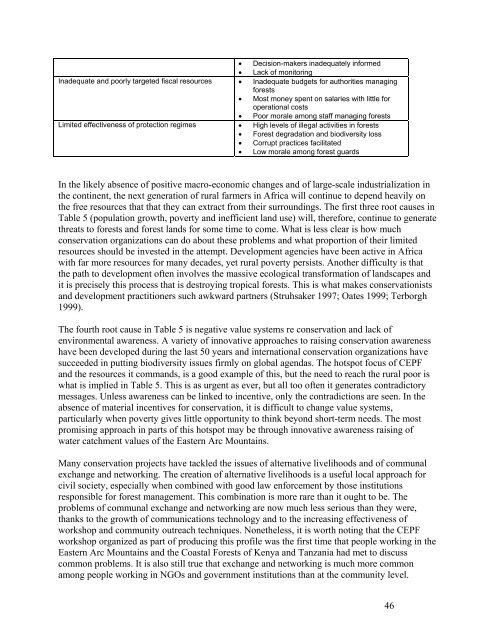Eastern Arc Mountains and Coastal Forests of Tanzania and Kenya ...
Eastern Arc Mountains and Coastal Forests of Tanzania and Kenya ...
Eastern Arc Mountains and Coastal Forests of Tanzania and Kenya ...
You also want an ePaper? Increase the reach of your titles
YUMPU automatically turns print PDFs into web optimized ePapers that Google loves.
• Decision-makers inadequately informed• Lack <strong>of</strong> monitoringInadequate <strong>and</strong> poorly targeted fiscal resources • Inadequate budgets for authorities managingforests• Most money spent on salaries with little foroperational costs• Poor morale among staff managing forestsLimited effectiveness <strong>of</strong> protection regimes • High levels <strong>of</strong> illegal activities in forests• Forest degradation <strong>and</strong> biodiversity loss• Corrupt practices facilitated• Low morale among forest guardsIn the likely absence <strong>of</strong> positive macro-economic changes <strong>and</strong> <strong>of</strong> large-scale industrialization inthe continent, the next generation <strong>of</strong> rural farmers in Africa will continue to depend heavily onthe free resources that that they can extract from their surroundings. The first three root causes inTable 5 (population growth, poverty <strong>and</strong> inefficient l<strong>and</strong> use) will, therefore, continue to generatethreats to forests <strong>and</strong> forest l<strong>and</strong>s for some time to come. What is less clear is how muchconservation organizations can do about these problems <strong>and</strong> what proportion <strong>of</strong> their limitedresources should be invested in the attempt. Development agencies have been active in Africawith far more resources for many decades, yet rural poverty persists. Another difficulty is thatthe path to development <strong>of</strong>ten involves the massive ecological transformation <strong>of</strong> l<strong>and</strong>scapes <strong>and</strong>it is precisely this process that is destroying tropical forests. This is what makes conservationists<strong>and</strong> development practitioners such awkward partners (Struhsaker 1997; Oates 1999; Terborgh1999).The fourth root cause in Table 5 is negative value systems re conservation <strong>and</strong> lack <strong>of</strong>environmental awareness. A variety <strong>of</strong> innovative approaches to raising conservation awarenesshave been developed during the last 50 years <strong>and</strong> international conservation organizations havesucceeded in putting biodiversity issues firmly on global agendas. The hotspot focus <strong>of</strong> CEPF<strong>and</strong> the resources it comm<strong>and</strong>s, is a good example <strong>of</strong> this, but the need to reach the rural poor iswhat is implied in Table 5. This is as urgent as ever, but all too <strong>of</strong>ten it generates contradictorymessages. Unless awareness can be linked to incentive, only the contradictions are seen. In theabsence <strong>of</strong> material incentives for conservation, it is difficult to change value systems,particularly when poverty gives little opportunity to think beyond short-term needs. The mostpromising approach in parts <strong>of</strong> this hotspot may be through innovative awareness raising <strong>of</strong>water catchment values <strong>of</strong> the <strong>Eastern</strong> <strong>Arc</strong> <strong>Mountains</strong>.Many conservation projects have tackled the issues <strong>of</strong> alternative livelihoods <strong>and</strong> <strong>of</strong> communalexchange <strong>and</strong> networking. The creation <strong>of</strong> alternative livelihoods is a useful local approach forcivil society, especially when combined with good law enforcement by those institutionsresponsible for forest management. This combination is more rare than it ought to be. Theproblems <strong>of</strong> communal exchange <strong>and</strong> networking are now much less serious than they were,thanks to the growth <strong>of</strong> communications technology <strong>and</strong> to the increasing effectiveness <strong>of</strong>workshop <strong>and</strong> community outreach techniques. Nonetheless, it is worth noting that the CEPFworkshop organized as part <strong>of</strong> producing this pr<strong>of</strong>ile was the first time that people working in the<strong>Eastern</strong> <strong>Arc</strong> <strong>Mountains</strong> <strong>and</strong> the <strong>Coastal</strong> <strong>Forests</strong> <strong>of</strong> <strong>Kenya</strong> <strong>and</strong> <strong>Tanzania</strong> had met to discusscommon problems. It is also still true that exchange <strong>and</strong> networking is much more commonamong people working in NGOs <strong>and</strong> government institutions than at the community level.46
















